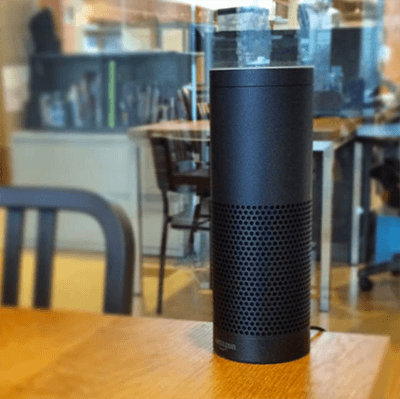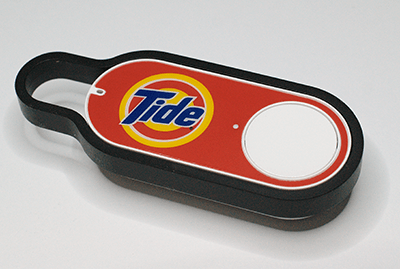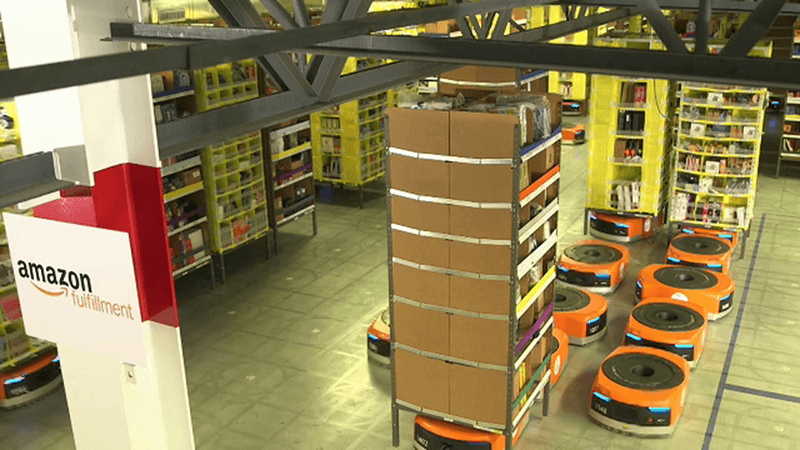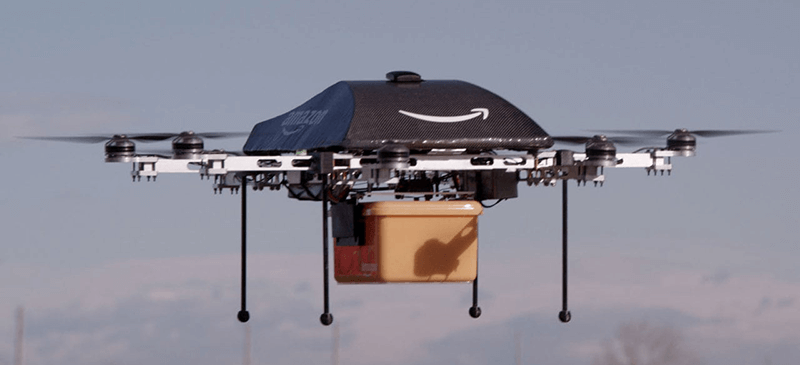Amazon – a prime example of an IoT implementation
Amazon accounts for more than half of every new dollar spent online in America today , as well as being the world’s leading provider of cloud computing services. Its logistics, computing and other services often aid other companies as well as supporting its own expansion. Given its breadth and depth of activities, Amazon could become a new kind of utility; one that provides the infrastructure of commerce, from computing power to payments to logistics.
With its size, spending power and grip on computing technology, it’s not surprising that the company is employing innovation and leadership to improve the customer experience, from order placement through to receipt of goods - or that it’s using the IoT extensively in ensuring that the entire end-to-end experience is smooth and seamless, even while new technologies are being brought into its fulfilment.
In this article, we look at Amazon’s futuristic approach, and just how it’s applying IoT technology to combine its services into an integrated order fulfilment solution. We also consider the implications of Amazon’s technologies for larger-scale IoT implementations, and see how smart homes and smart cities can become part of a single environment. Finally, we show how Amazon is providing a platform for third-party IoT developers through its AWS operation.
An end to end service
In some ways, Amazon is doing what it’s always done; allowing users to choose, order and receive goods and services in the comfort of their own home. However, their continuous investment in and deployment of new technology is making the ordering activity easier and more convenient, while delivery times are being reduced. In the process, Amazon is making itself a more integrated part of consumers’ everyday lives.
Amazon is working on every aspect of their fulfilment chain, from order to delivery. For convenience, we can divide this chain into three segments; in-home ordering, warehouse processing, and delivery.
Home automation and order placement
While ordering from a PC, tablet or smartphone is still possible and will remain so, newer routes are bringing Amazon into the smart home environment. They make the company a more intimate part of everyday living, with no need to disengage from other activities and go to a computer terminal or even smartphone.
One route is Alexa ; a virtual assistant that lives in Amazon Echo, an always on, always listening Internet-connected speaker. Alexa is also available within other, cheaper speaker devices such as Tap or Echo Dot, as well as Fire TV. Among her range of different command types, she can be asked to order products offered on Amazon Prime, with some exceptions; this means millions of items are available. After learning additional ‘skills’, Alexa can also order third-party products and services such as Domino’s pizza or an Uber ride.
To make a purchase, simply speak to Alexa to wake her, then ask for a product. She will offer a Prime product, with its cost – just say ‘yes’ to buy it. This process, which is so easy for users, is the result of complex speech science engineering that took a while to accomplish.
Alexa also facilitates home automation and talks to your smart home devices, being directly compatible with products such as Philips Hue and Lifx smart lightbulbs, plus smart switches and thermostats. It also accesses further devices through hubs such as Wink. Note that the devices do not talk directly to Alexa, or to one another; all communication is via the cloud.

Fig.1: Amazon Echo listening speaker

Fig.2: Amazon Dash button
For some Prime products, purchasing can be made even simpler with Dash buttons; little Wi-Fi devices that are dedicated to single products. For example, pair a Dash Button to a detergent, and attach it to your washing machine. When you’re running low, press the button to order more detergent, and it will arrive automatically on next-day delivery. The Dash buttons can be set up using a smartphone app, and order status can be checked online. Protection against inadvertent multiple button presses is provided, and the button is effectively free to Amazon Prime members.
Amazon is also rolling out an even more highly automated smart home service: Dash Replenishment Service (DRS). This is a Cloud-based platform that allows connected IoT devices to automatically re-order their own supplies when they run low. The company is currently working with Bosch, Siemens, Grundig, Samsung and Whirlpool as partners for this platform.
Amazon Dash Scanner is another development now available; it can be used with the AmazonFresh service in London.
Fulfilment centres, advanced technology and man/machine symbiosis
Amazon’s global fulfilment network currently has 80 fulfilment centres worldwide, and 12 in the UK, while the company continues to build more. This improves their ability to offer extremely short delivery times in more locations, measured in hours rather than days; a development that allows handling of perishable items such as groceries. The network is managed by Amazon Fulfillment Technologies (AFT), which designs and builds the hardware, software, and processes needed to handle billions of customer orders on time.
The company has always invested heavily in technology, and AFT is innovating with robotics, computer vision, machine learning, and operations research. However, Amazon recognises people’s capabilities equally, and AFT believes in a symbiotic relationship where automation and employees are both deployed where they do best.
At the centre of the fulfilment activity, robots rearrange shelves or carry them to workers who retrieve goods for packaging, or restock them. The robots are controlled by a central computer and navigate using markers on the ground. The process uses space efficiently, and is faster than having workers walking around.
The remainder of the warehouse is just as highly automated. At Goods In, vision systems recognise products as they are unpacked. Towards Goods Out, workers pack products for shipping with help from Amazon’s central computer systems. Items retrieved from storage shelves are automatically identified and sorted into batches destined for a single customer.
The computer system knows the dimensions of each product and will automatically allocate the right box, and even the right amount of packing tape. Further along, before products are sent to different trucks for dispatching, boxes are weighed to ensure no mistakes have been made in packing.
Robots are becoming cheaper, safer and learn faster thanks to better processor ICs, algorithms, actuators and sensors. However, they are incapable of fine manipulation or improvisation, so need to collaborate with humans effectively in an ongoing productive relationship.

Fig.3: Kiva robots in an Amazon fulfilment centre
Delivery solutions and futuristic developments
Having a fulfilment centre in every locality is one way of reducing delivery times, and Amazon is working on this as described above. At the same time, the company is addressing its delivery channels with equal vigour. These activities encompass not only their well-publicised drone experiments, but also ground-based transportation options.
As Amazon constantly seeks to improve speed of delivery, they see drones as a potentially important part of the solution. Currently, barriers to wider use relate more to legislative than to technical issues. In the US, for example, the FAA states that a delivery drone cannot fly out of the unaided sight of its pilot, and each pilot can only control one drone.

Fig.4: Amazon drone
More progress is being made in the UK, where CAA regulations are a little more lenient. In December 2016, a trial delivery was made to a customer in Cambridge; they received their shipment thirteen minutes after placing their order.
The operation is based on a drone sitting at the end of a conveyor belt, waiting to pick up a package of less than 5 lb and deliver it to a destination up to 10 miles from the fulfilment centre in less than half an hour. Throughout each flight, the drones are guided by GPS, and are entirely autonomous.
Amazon’s chief Jeff Bezos believes drones will become a reality in four to five years, when FAA issues have been resolved.
The company’s developing ground vehicle strategy also has futuristic elements. It has assembled a team to investigate autonomous vehicle and truck technology, and how it can boost the company’s quest for faster deliveries.
Amazon already has some presence in the automotive space; Alexa can communicate with connectivity systems in Ford, BMW, Hyundai-Genesis and Volkswagen vehicles. Meanwhile, VW is directly integrating Alexa into a vehicle infotainment system, as opposed to Alexa being connected through a smartphone.
The bigger connectivity picture – from smart homes to smart cities
Above, we have seen how Alexa can interact through the cloud, either directly or indirectly, with other connected devices to build a smart home environment. Alexa’s factors of voice control, wide connectivity and cloud presence open many possibilities. For example, the technology could be scaled into industrial-scale applications such as a building management system (BMS) in a commercial, corporate or other large-scale built environment.
Firstly, all devices installed in a building, such as boilers, chillers, generator sets, electric sub-meters, pumps, VAV controllers, fire panels and others could be smart and have their own individual cloud points-of-presence and applications, just as consumer devices do. Once all the devices and sub-systems (and their access and data) are represented in the cloud, the facility manager could develop their own Alexa-inspired BMS - an integrated point of control that is intuitive and fun to use. It may not be as easy as the home Alexa, but that should be the goal.
In other scenarios, smart homes could become integrated into smart cities. The local government in Louisville, Kentucky , for example, is currently working on this concept. In connected homes, Phillips Hue lamps will change colour depending on air pollution levels being experienced in the city. On receipt of an ozone alert, the lamps turn red. Residents can also ask Alexa about the date of the next rubbish pickup in their neighbourhood, or for a daily flash briefing from the Mayor’s office.
Infineon Technologies AG, a company that offers semiconductor and system solutions for energy efficiency, mobility and security, recognises the potential of intelligence in connected household appliances. Such machines could protect themselves from incoming power surges by isolating themselves, preventing costly damage. They could also react to grid conditions, so that if the grid is in danger of failing, appliances could voluntarily reduce their load to keep it alive.
Amazon’s wider impact: support for third-party IOT developers
While growing ever-stronger automation capabilities and their IoT presence to further their own business activities, Amazon has generated tools that provide third parties with IoT development opportunities.
Entry into this environment can be relatively simple; a supplier might arrange for a Dash button to handle their products, for example. They can also access Amazon’s open Applications Programming Interface (API) to create new Skills for Alexa. These Skills could relate to third party services like Uber as mentioned above, or for controlling smart devices at home.
However, a more comprehensive offering is available in the form of Amazon Web Services (AWS). AWS comprises a broad set of global cloud-based products including compute, storage, databases, analytics, networking, mobile, developer tools, management tools, IoT services, security and enterprise applications. Customers can use these services for rapid solutions development, and can optionally add solutions provided by Amazon’s partners.
Cities are using these tools to develop innovative applications for transport and mobility, public safety, public health and the environment. One example is Park Smart, a software platform which indicates in real time the availability of parking lots in monitored areas. The software uses the physical infrastructure of video sensors, including existing sensors, to process the images, and provide information on parking availability to a mobile app. The system monitors not only the single parking space but even each car parked.
In public health applications, remote monitoring solutions such as those enabled by IoT and voice enabled technology can give healthcare providers the option to move patients to their home and still monitor status; reducing overall cost of treatment without impacting level of care.

Fig. 5: Healthcare providers now have the option to move patients to their home and still monitor status - Image via Wikimedia
Conclusions
In this article, we have seen some key technologies that Amazon has put into place, and is continuing to develop. With this effort, Amazon has become a large and successful IoT infrastructure; one that gives its users more choice, more convenience, better services and faster deliveries.
In fact, the company’s IoT presence has multiple dimensions. Primarily it performs as an end-to-end implementation, with Alexa, Dash buttons and other devices acting as sensors, drones and possibly autonomous trucks planned to take an increasing role as actuators, and all devices working through Amazon’s cloud resources and fulfilment centres.
Additionally, Alexa can play an important and central part in smart home schemes, even without her role in order fulfilment. She can communicate with a large number of smart devices directly, and many more sensors through suitable hubs. Her voice control and cloud capabilities can also be scaled into larger industrial or infrastructure applications.
Finally, while building its own IoT infrastructure, Amazon is facilitating IoT development for many different third party companies as well. This can be relatively simple, like giving suppliers coding access to Alexa and Dash, or large-scale development support through Amazon Web Services (AWS).
References
“Amazon’s empire”, The Economist, March 25th, 2017
www.cnet.com/how-to/amazon-alexa-device-compatibility-how-tos-and-much-more
www.wired.co.uk/article/amazon-dash-uk-launch-price-brands
fortune.com/2016/01/19/amazon-opens-dash-replenishment
www.engadget.com/2016/07/28/amazon-dash-fresh-grocery-uk
www.cnet.com/news/when-a-smart-apartment-meets-a-smart-city
www.infineon.com/cms/en/applications/consumer/home-appliances/washing-machines/#!documents
Amazon – a prime example of an IoT implementation Date published: 14th June 2017 by Farnell